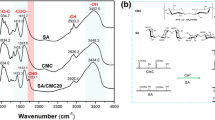Abstract
Porous ceramic/agarose composite beads were derived as a kind of glutathione S-transferase (GST) affinity medium to investigate the characteristics and application in fast protein liquid chromatography. The analysis of back pressure and chromatographic performance in a packed bed indicated that this kind of affinity medium with a rigid structure and a high level of column efficiency would be suitable for protein chromatography under high flow velocity. The good physical stability evidenced under harsh alkaline treatments ensured the application in real chromatography processes. When the porous ceramic/agarose composite beads were used in the purification process of fusion protein GST-ADAM15, the purity of the total GST related protein reached more than 91.6 % and the yield reached 44.6 % even at the flow velocity of 764.3 cm h−1. The works indicated the characteristics of porous ceramic/agarose composite beads and their potential application in protein purification processes.





Similar content being viewed by others
References
Pålsson E, Gustavsson PE, Larsson PO (2000) J Chromatogr A 878:17–25
Miao ZJ, Lin DQ, Yao SJ (2005) Ind Eng Chem Res 44:8218–8224
Xia HF, Lin DQ, Yao SJ (2007) J Chromatogr A 1175:55–62
Tong XD, Sun Y (2002) J Chromatogr A 943:63–75
Lei YL, Lin DQ, Yao SJ, Zhu ZQ (2003) J Appl Polym Sci 90:2848–2854
Stella C, Rudaz S, Veuthey JL, Tchapla A (2001) Chromatographia 53:S113–S131
Nawrockia J, Dunlapb C, McCormickc A, Carrd PW (2004) J Chromatogr A 1028:1–30
Claessensa HA, van Stratena MA, Kirkland JJ (1996) J Chromatogr A 728:259–270
Horvath J, Boschetti E, Guerrier L, Cooke N (1994) J Chromatogr A 679:11–22
Boschetti E, Guerrier L, Girot P, Horvath J (1995) J Chromatogr B Biomed Sci Appl 664:225–231
Fernandez MA, Carta G (1996) J Chromatogr A 746:169–183
Necina R, Amatschek K, Jungbauer A (1998) Biotechnol Bioeng 60:689–698
Hansen E, Mollerup J (1998) J Chromatogr A 827:259–267
Garke G, Deckwer WD, Anspach FB (2000) J Chromatogr B Biomed Sci Appl 737:25–38
Xia HF, Jin XH, Wu PQ, Zheng ZY (2012) J Chromatogr A 1223:126–130
Tao YY, Almodovar EXP, Carta G, Ferreira G, Robbins D (2011) J Chromatogr A 1218:8027–8035
Almodovar EXP, Tao YY, Carta G (2011) Biotechnol Prog 27:1264–1272
Arribas J, Bech-Serra JJ, Santiago-Josefat B (2006) Can Metast Rev 25:57–68
Wu J, Zhang Lf, Lei JY, Cai GM, Zhu W, Lu DR, Jin J (2009) Appl Biochem Biotechnol 157:299–310
Sundberg L, Porath J (1974) J Chromatogr A 90:87–98
Zhou ND, Li Y, Chen J, Ruan WQ, Lun SY (1997) Biotechnol (in Chinese) 7:30–33
Huang CJ, Chen CY (2005) Biochem Biophys Res Comm 327:8–17
Laemmli UK (1970) Nature 227:680–685
Bradford MM (1976) Anal Biochem 72:248–254
Bidlingmeyer BA, Warren JrFV (1984) Anal Chem 56:1583–1596
Zhai YQ, Zhou WQ, Wei W, Qu JB, Lei JD, Su ZG, Ma GH (2012) Anal Chim Acta 712:152–161
Jungbauer A (2005) J Chromatogr A 1065:3–12
Boschetti E (1994) J Chromatogr A 658:207–236
Wu J, Lei JY, Zhang Lf, Hua H, Jin J (2008) Acta Microbiol Sin 48:1067–1074
Acknowledgments
This work was supported by the National High Technology Research and Development Program of China (863 Program, 2012AA021201), the National Natural Science Foundation of China (21206054), the Research Fund for the Doctoral Program of Higher Education of China (20110093120001), the Natural Science Foundation of Jiangsu Province of China (BK2011186), the 111 Project (No. 111-2-06), and the Project Funded by the Priority Academic Program Development of Jiangsu Higher Education Institutions.
Author information
Authors and Affiliations
Corresponding author
Rights and permissions
About this article
Cite this article
Xia, HF., Wang, SL., Jin, XH. et al. Characteristics and Application of Porous Ceramic/Agarose Composite Beads Derived as an Affinity Medium. Chromatographia 77, 25–30 (2014). https://doi.org/10.1007/s10337-013-2578-4
Received:
Revised:
Accepted:
Published:
Issue Date:
DOI: https://doi.org/10.1007/s10337-013-2578-4




